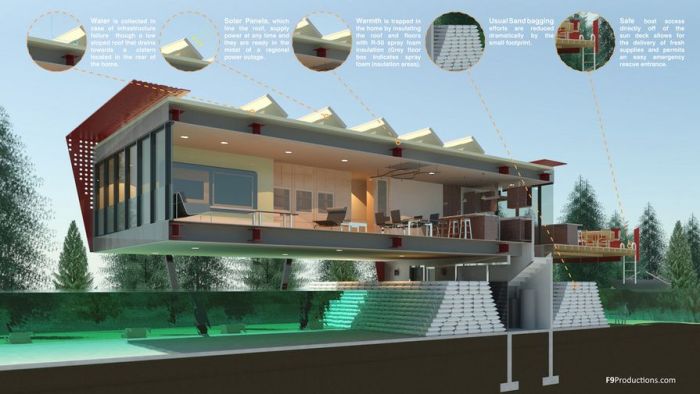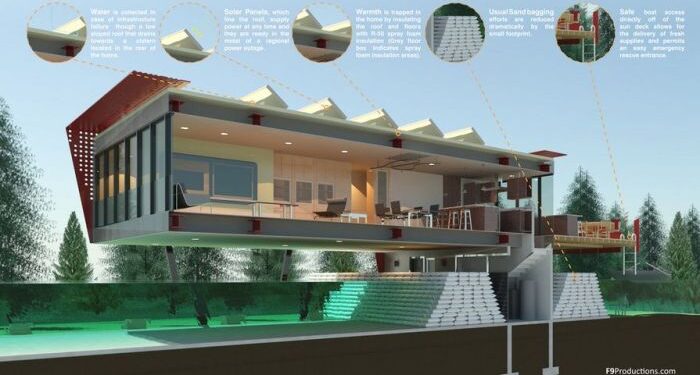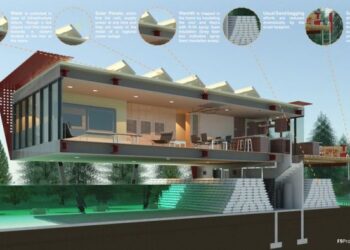Embarking on the journey of Architectural design for disaster-resilient buildings, we delve into the crucial aspects that shape buildings to withstand the forces of nature. From innovative technologies to real-life examples, this topic encompasses a wide array of strategies aimed at creating resilient structures.
Importance of Disaster-Resilient Architectural Design

Designing buildings to withstand natural disasters is crucial for the safety and well-being of individuals and communities. By incorporating disaster-resilient features into architectural design, we can mitigate the impact of calamities and save lives.
One real-life scenario where disaster-resilient design made a significant difference is the Tohoku earthquake and tsunami that struck Japan in 2011. The Sendai Mediatheque, designed by architect Toyo Ito, demonstrated the importance of flexible and resilient structures in surviving such catastrophic events.
Despite being located near the epicenter of the earthquake, the building remained standing due to its innovative design and materials.
Role of Architectural Design in Minimizing Disaster Impact
Architectural design plays a crucial role in minimizing the impact of disasters on communities. By incorporating elements such as earthquake-resistant foundations, flood-proofing techniques, and fire-resistant materials, architects can help communities bounce back more quickly after a disaster. Additionally, proper planning and design can ensure that essential infrastructure remains intact, enabling faster recovery and reducing overall damage.
Key Principles in Architectural Design for Disaster Resilience
When it comes to creating disaster-resilient buildings, there are key principles that architects need to consider. These principles encompass a range of factors that contribute to the overall resilience of a structure.
Material Selection
Material selection is a crucial aspect of disaster-resilient architectural design. Architects must choose materials that can withstand the impact of natural disasters such as earthquakes, hurricanes, and floods. For example, using reinforced concrete or steel frames can enhance the structural integrity of a building and reduce the risk of collapse during a disaster.
Structural Integrity
Ensuring structural integrity is another fundamental principle in disaster-resilient design. Architects need to consider the load-bearing capacity of the building, the placement of columns and beams, and the overall stability of the structure. By designing buildings with strong foundations and resilient structural systems, architects can minimize the risk of damage and ensure the safety of occupants.
Site Planning
Site planning plays a crucial role in disaster-resilient architectural design. Architects must assess the natural hazards present in the area, such as flood zones, seismic activity, or high winds, and tailor the design of the building to mitigate these risks.
Factors like building orientation, elevation, and landscaping can all contribute to the overall resilience of a structure.
Aesthetics vs. Functionality
Balancing aesthetics and functionality is a challenge in disaster-resilient design. While it is important for buildings to be visually appealing, architects must prioritize functionality and resilience above all else. This may involve making design choices that prioritize safety, durability, and sustainability over purely aesthetic considerations.
Innovative Technologies and Materials

In the realm of disaster-resilient architectural design, the use of innovative technologies and materials plays a crucial role in enhancing the structural integrity and durability of buildings. These advancements have significantly improved the ability of structures to withstand various natural disasters.
Advanced Construction Materials
One key aspect of disaster-resilient architectural design is the utilization of advanced construction materials. Materials such as high-strength concrete, fiber-reinforced polymers, and impact-resistant glass have revolutionized the construction industry by offering increased durability and resistance to extreme weather events. The incorporation of these materials into building designs helps to minimize damage and ensure the safety of occupants during disasters.
Smart Systems Integration
The integration of smart systems, such as IoT sensors, automated shut-off valves, and real-time monitoring systems, has become increasingly popular in disaster-resilient architectural design. These systems provide early warning alerts, facilitate quick responses, and enable efficient resource management during emergencies.
By leveraging smart technologies, buildings can adapt to changing conditions and mitigate the impact of disasters effectively.
Sustainable Practices
In addition to advanced materials and smart systems, sustainable practices also play a vital role in disaster-resilient architectural design. Green building techniques, energy-efficient designs, and renewable energy sources not only reduce the environmental impact of buildings but also enhance their resilience to disasters.
By incorporating sustainable practices, architects and engineers can create buildings that are not only durable and safe but also environmentally friendly.
Case Studies and Best Practices
When it comes to disaster-resilient architectural design, studying successful case studies and best practices is crucial to understanding what works and what doesn't in creating buildings that can withstand natural disasters. By analyzing past examples, architects and engineers can learn valuable lessons to improve future designs.
Case Study 1: The Tohoku Earthquake and Tsunami Resistant Design in Japan
Following the devastating Tohoku earthquake and tsunami in 2011, Japan implemented strict building codes and innovative design features to enhance disaster resilience. One notable example is the Rikuzentakata Disaster Prevention Center, which withstood the disaster due to its elevated design and reinforced structure.
Case Study 2: The Resilient Homes Project in New Orleans, USA
After Hurricane Katrina in 2005, the Resilient Homes Project in New Orleans focused on building affordable, disaster-resilient homes for low-income families. These homes incorporated flood-resistant materials, elevated foundations, and storm-resistant windows to mitigate the impact of future hurricanes.
Best Practices in Disaster-Resilient Architectural Design
- Conducting thorough risk assessments to identify potential hazards and vulnerabilities.
- Implementing strong and flexible building materials that can withstand extreme weather conditions.
- Incorporating redundant systems for critical infrastructure to ensure functionality during disasters.
- Designing buildings with proper ventilation and natural lighting to enhance occupant comfort during emergencies.
Lessons Learned from Past Failures
- Failure to consider local environmental conditions and historical disaster patterns can lead to inadequate design.
- Ignoring the importance of community engagement and feedback can result in designs that do not meet the needs of residents.
- Underestimating the long-term impacts of disasters on building structures can lead to costly repairs and reconstruction.
Closing Summary
In conclusion, Architectural design for disaster-resilient buildings is not just about constructing sturdy edifices; it's about safeguarding communities and shaping a more resilient future. By implementing best practices and embracing technological advancements, architects play a pivotal role in mitigating the impact of disasters.
Top FAQs
How does architectural design contribute to minimizing the impact of disasters?
Architectural design influences factors like building material selection and structural integrity, crucial for creating resilient structures that can withstand disasters.
What are some key principles architects should consider for disaster-resilient buildings?
Architects should focus on factors like material selection, structural integrity, and site planning to enhance the resilience of buildings.
How have advancements in construction materials improved disaster resistance?
Modern construction materials offer enhanced durability and strength, crucial for building disaster-resilient structures.









